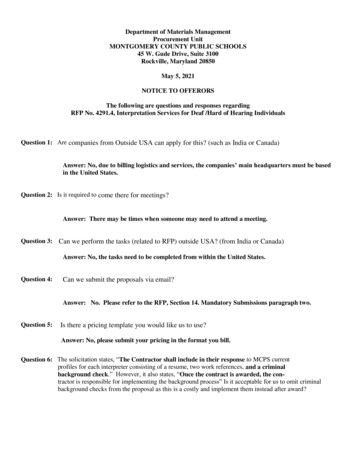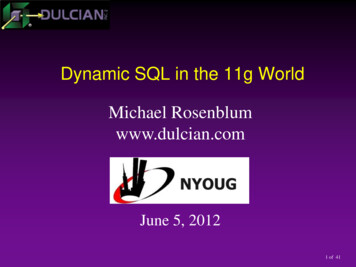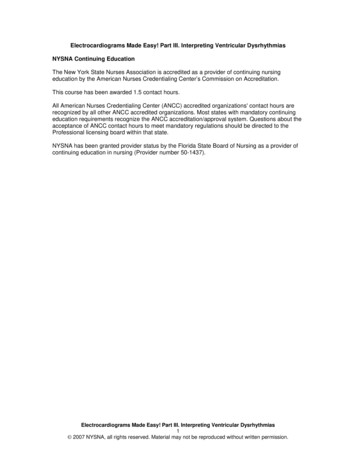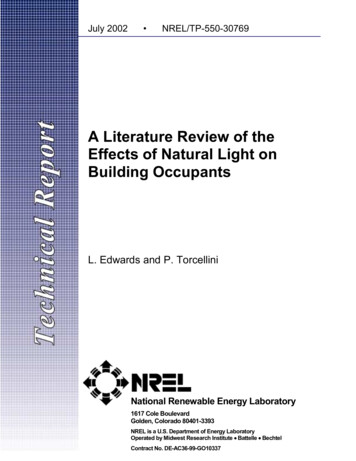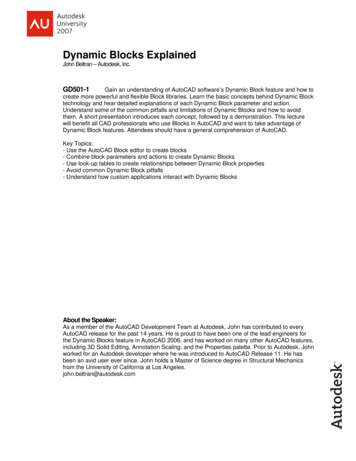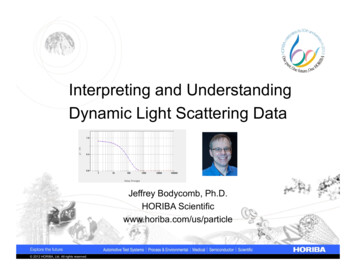
Transcription
Interpreting and UnderstandingDynamic Light Scattering DataJeffrey Bodycomb, Ph.D.HORIBA Scientificwww.horiba.com/us/particle 2012 HORIBA, Ltd. All rights reserved.
Outline“Kitchen sink” talk. I cover a range of topicswith an emphasis on conclusions rather thanderivations. Introduction Looking at the ACF Effect of temperature and what it meansto you. The Z-average Effect of concentration Hydrodynamic size 2012 HORIBA, Ltd. All rights reserved.
What is Dynamic Light Scattering? Dynamic light scattering refers tomeasurement and interpretation of lightscattering data on a microsecond timescale. Dynamic light scattering can be used todetermine Particle/molecular size Size distribution Relaxations in complex fluids 2012 HORIBA, Ltd. All rights reserved.
Particle Diameter ( dalMacromoleculesSuspensions and Slurries1000CoarsePowdersMethodsElectron MicroscopeAcoustic SpectroscopyLight ObscurationLaser Diffraction - LA950Electrozone SensingDLS – SZ-100Disc-Centrifuge (CPS)Microscopy CamSizer 2012 HORIBA, Ltd. All rights reserved.
Use the Right Tool It is a struggle to use a micrometer withthis steel block. It’s easy with a steel rule (or calipers). The same applies for particles 2012 HORIBA, Ltd. All rights reserved.
Particle Sizes over 1 micron Note that the upper limit of DLS is at 8microns. This depends on particledensity and other factors. Rule of thumb: If your particles areroutinely bigger than 1 micron, considerlaser diffraction. Particles that are too big often appearas 10 20 microns in DLS results. Youwill not be trapped by big particles thatseem small. 2012 HORIBA, Ltd. All rights reserved.
Brownian MotionParticles in suspension undergo Brownian motion due to solventmolecule bombardment in random thermal motion. Brownian Motion Random Related to Size Related to viscosity Related to temperature 2012 HORIBA, Ltd. All rights reserved.
The SZ-100 Single compact unit that performs size,zeta potential, and molecular weightmeasurements. 2012 HORIBA, Ltd. All rights reserved.
Correlation Function Random fluctuations are interpreted in termsof the autocorrelation function (ACF).TC ( ) I (t ) I (t )dt0I (t ) I (t )C ( ) 1 exp( 2 ) 2012 HORIBA, Ltd. All rights reserved.
Smooth Autocorrelation Function These look good. As size increases,decay moves tolonger times. Not enough datato decide ifconcentration istoo high. 2012 HORIBA, Ltd. All rights reserved.35 nm70 nm110 nm
Effect of Dust and Contamination These are examplesof questionable data. Either the particle ofinterest is too largeor there are too manylarge particleimpurities. Filter samples or usesoftware noise cutfunction. 2012 HORIBA, Ltd. All rights reserved.LA-950 candidateboulders
Gamma to Size Dm qq 4 n 2 2 sin k BTDh 3 (T ) DtNote effect of temperature! 2012 HORIBA, Ltd. All rights reserved. decay constantDt diffusion coefficientq scattering vectorn refractive index wavelength scattering angleDh hydrodynamic diameter viscositykB Boltzman’s constant
Effect of Temperature (and trends) Look at Z-average size. Data is OK. Is there a trend? Probably sample is not to temperature and viscosityvalue used in calculation is incorrect. In this case, I set up measurement conditions to force thisevent. 2012 HORIBA, Ltd. All rights reserved.
Viscosity Get your viscosity correct. Choose the right liquid. Use viscosity at temperature of measurement. 2012 HORIBA, Ltd. All rights reserved.
Why Z-average? Numerically stable Result is not overly sensitive to noise in thedata. Important for QC work Described in detail in ISO standards ISO-22412:2008 as d DLS ISO-13321:2004 as xPCS It is a useful measure of size since asaverage size increases, so does Zaverage. 2012 HORIBA, Ltd. All rights reserved.
Huh? What is the Z-average?Determined by a mathematical method known ascumulants. 2012 HORIBA, Ltd. All rights reserved.
The equations1 Dz f D P( )D f D P( )6iii 1i6iAssume small angle compared to size so P(θ) 1DzfD fDii 2012 HORIBA, Ltd. All rights reserved.6i5i
Particle Size Distributions Particle size distributions can be plotted in several ways. Most often you see volume (mass) and number distributions 2012 HORIBA, Ltd. All rights reserved.
A new distribution: Intensity Scattering goes by d6 The exponent works for small particles. We do the fullcalculations. 2012 HORIBA, Ltd. All rights reserved.
Look at a linear scale These are lognormal distributions, so asymmetric. 2012 HORIBA, Ltd. All rights reserved.
Need to use Diffusion Coefficient These are lognormal distributions, so asymmetric. 2012 HORIBA, Ltd. All rights reserved.
Z-average As average size increases, so does Zaverage. Tends to weight larger particles morethan smaller (due to the physics of themeasurement). 2012 HORIBA, Ltd. All rights reserved.
Reproducibility PSL standards: you can get resultsbetter than 1% Don’t expect this all the time. Expect 3 5% This is for Z-average. Other average values (e.g., volumeweighted mean) tend to vary more. PI varies more. 2012 HORIBA, Ltd. All rights reserved.
Comparing Techniques Always a good idea to check your results. Don’t expect an exact match. Differences of 10 20% between laserdiffraction (LD) and DLS are to be expected.100 nm PSL1 micron PSLE-1E-2E-3E-4Ludox 0.01 M KClCoffee Creamer wet 2012 HORIBA, Ltd. All rights reserved.D50(vol. basis),nmLD1011059129.8149.8110.049.436354D50% diff inZ-avg.% diff in size(vol. basis),D50Diameter,nmnm(DLS 215.8-39.1336.9-4.8
Effect of Concentration Best is to make a study of measuredsize vs. concentration Note range of concentrations for whichdata is independent of concentration. Example below is “fake” data. 2012 HORIBA, Ltd. All rights reserved.
What is Hydrodynamic Size? DLS gives the diameter of a sphere thatmoves (diffuses) the same way as yoursample.Dh 2012 HORIBA, Ltd. All rights reserved.DhDh
Why DLS? Non-invasive measurement Fast results Requires only small quantities ofsample Good for detecting trace amounts ofaggregate Good technique for macro-molecularsizing 2012 HORIBA, Ltd. All rights reserved.
The SZ-100 from s/particleJeff.Bodycomb@horiba.com 2012 HORIBA, Ltd. All rights reserved.
ありがとうございましたCảm ơnขอบคุณครับ谢谢Graciasُ ا ش ْكر Σας ευχαριστούμεTacka dig감사합니다 2012 HORIBA, Ltd. All rights reserved.ध यवादGrazieநன்றDankeБольшое спасибоObrigado
2012 HORIBA, Ltd. All rights reserved. What is Dynamic Light Scattering? Dynamic light scattering refers to measurement and interpretation of light
